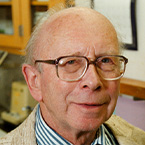
An icon to a generation of scientists, Dr. Pardee has done much to advance our understanding of molecular biology. He took part in what has become known as the “PaJaMo (Pardee/Jacob/Monod) experiment” at the Institut Pasteur in Paris in the late 1950s, which led scientists to question how genetic information could be converted to protein so quickly. This in turn led to the discovery in 1960 of messenger RNA (mRNA). In the 1970s he discovered the restriction point (sometimes called the Pardee point) in which a cell commits itself to certain cell cycle events during the G1 cycle. He also invented differential display, a method to detect the mRNAs expressed in a given cell type, a method that has been widely used by researchers to isolate genes of interest.
Dr. Pardee is the recipient of numerous awards and has held office in many professional organizations. As a leader of the AACR in the 1980s, he worked to strengthen programs in molecular biology and genetics, which have attracted many molecular biologists over the years and are areas that permeate the Association’s scientific programs today.
Career Highlights
1999 Distinguished Alumni Award, California Institute of Technology
1998 Boehringer Mannheim Award
1985-1986 President, AACR
1983-1986 Board of Directors, AACR
1980 FASEB 3M Award
1980 President, American Society of Biological Chemists
1975 Professor, Biological Chemistry and Molecular Pharmacology, Harvard Medical School, and Dana-Farber Cancer Institute, Boston MA
1975 Rosenstiel Medal
1974 Elected Member, Institute of Medicine
1973 Sir H. A. Krebs Medal, Federation of European Biochemical Societies
1968 Elected Member, National Academy of Sciences, Washington, D.C.
1963 Elected Fellow, American Academy of Arts and Sciences
1961-1974 Professor of Biochemical Sciences, Princeton University
1960 Paul Lewis Award, American Chemical Society
1947 PhD, California Institute of Technology